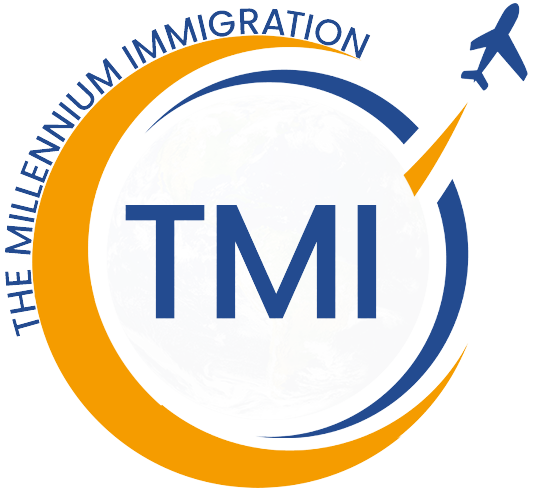- 1011 Parsons Road SW, Edmonton, AB T6X 0X2 - CANADA

- Office # 6, Second Floor, Blook-D, Spring North Commercial, Phase-7, Bahria Town, Islamabad

1011 Parsons Road SW, Edmonton, AB T6X 0X2 - CANADA
Office # 6, Second Floor, Blook-D, Spring North Commercial, Phase-7, Bahria Town, Islamabad
1011 Parsons Road SW, Edmonton, AB T6X 0X2 - CANADA

Office # 6, Second Floor, Blook-D, Spring North Commercial, Phase-7, Bahria Town, Islamabad


THE MILLENNIUM IMMIGRATION
FROM HOPE TO REALITY
FREE ASSESSMENT

Introduction
Over the past decade, Canada’s Express Entry system has revolutionized the country’s immigration process. Introduced in January 2015, Express Entry was designed to attract skilled workers who could contribute to Canada’s economy and address labor shortages. Over the years, this system has undergone multiple changes, adapting to economic demands and immigration policies. This article explores how Express Entry has shaped Canadian immigration, analyzing its impact, trends, and future outlook.

The Evolution of Express Entry (2015-2024)
The Express Entry system operates through three primary economic immigration programs:
- Federal Skilled Worker Program (FSWP)
- Federal Skilled Trades Program (FSTP)
- Canadian Experience Class (CEC)
Initially, the system focused on attracting highly skilled workers based on the Comprehensive Ranking System (CRS), which evaluates candidates on age, education, work experience, and language proficiency. Over time, Immigration, Refugees and Citizenship Canada (IRCC) introduced various policy changes, including category-based selection, targeted draws, and priority occupations, to address labor shortages in specific industries.
Key Impacts of Express Entry on Canadian Immigration
1. Increased Immigration Numbers
Canada has witnessed a significant rise in skilled immigrants due to Express Entry. The number of invitations to apply (ITAs) has grown steadily, with annual targets increasing under the Immigration Levels Plan. By 2023, Canada aimed to welcome 465,000 new permanent residents, with a large portion coming through Express Entry.
2. Faster Processing Times
Before Express Entry, immigration applications took years to process. With its introduction, processing times were reduced to six months or less for most applicants, making Canada a more attractive destination for skilled professionals worldwide.
3. Higher CRS Score Requirements
Over the years, CRS cut-off scores have fluctuated. While early draws saw scores in the 450-470 range, recent trends show increased competition, with scores sometimes exceeding 500 points. This shift has encouraged candidates to improve their profiles through education, additional work experience, and provincial nominations.

4. Rise of Provincial Nominee Program (PNP) Integration
Provinces have leveraged Express Entry to address their specific labor market needs. Through PNP-aligned Express Entry streams, provinces nominate candidates with in-demand skills, increasing their CRS scores by 600 additional points, virtually guaranteeing an ITA.
5. Shift Towards Targeted Occupations and Category-Based Draws
To address labor shortages, IRCC introduced category-based selection in 2023, prioritizing candidates in sectors like healthcare, STEM, skilled trades, transport, and agriculture. This shift marked a move towards demand-driven immigration, ensuring industries facing worker shortages receive the required talent.
Challenges and Criticisms
While Express Entry has been largely successful, certain challenges remain:
- High CRS cut-off scores make it difficult for many candidates to receive an ITA.
- Backlogs and processing delays due to high application volumes.
- Preference for younger candidates, making it harder for older professionals to qualify.
- Limited opportunities for lower-skilled workers, despite labor shortages in non-technical industries.
The Future of Express Entry
Looking ahead, Express Entry is expected to evolve further to meet Canada’s economic and demographic needs. Future trends may include:
- More industry-specific draws targeting key sectors.
- Expanded pathways for international students and workers.
- Continued integration with PNPs to enhance regional immigration.
- AI-driven improvements for faster processing and better candidate assessment.

Conclusion
The past ten years have proven that Express Entry is a cornerstone of Canada’s immigration strategy. Its adaptability and efficiency have made it a preferred pathway for skilled immigrants worldwide. As Canada continues to refine its policies, Express Entry will remain a crucial tool in shaping the nation’s economic and demographic future.
FAQ’s
What is Express Entry?
Express Entry is an online immigration system used by the Canadian government to manage applications for permanent residence from skilled workers.
How does the Comprehensive Ranking System (CRS) work?
The CRS assigns points based on factors like age, education, work experience, and language skills. Higher scores increase the chances of receiving an Invitation to Apply (ITA).
What are the main programs under Express Entry?
Express Entry includes the Federal Skilled Worker Program (FSWP), Federal Skilled Trades Program (FSTP), and Canadian Experience Class (CEC).
How often are Express Entry draws held?
Draws typically occur every two weeks, but this frequency may vary depending on government policies and application backlogs.
Can I improve my CRS score?
Yes, you can enhance your CRS score by improving language proficiency, gaining more work experience, obtaining a job offer, or securing a Provincial Nomination.
How long does Express Entry processing take?
Most applications are processed within six months or less, but this may vary based on application volume and documentation.
Are there age restrictions for Express Entry?
While there is no maximum age limit, applicants aged 20-29 receive the highest CRS points for age. Older applicants may need to compensate with higher scores in other categories.